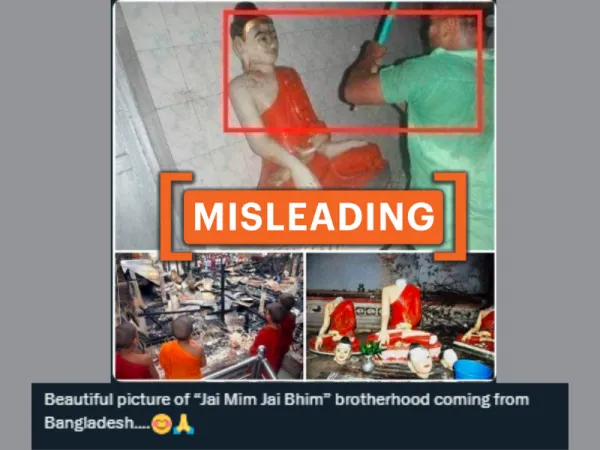By: Annet Preethi Furtado
August 9 2024
 Screenshots of the viral claim, which falsely alleges that a collage of images depicts broken idols and destruction from the ongoing violence in Bangladesh. (Source: X/Screenshot/Modified by Logically Facts)
Screenshots of the viral claim, which falsely alleges that a collage of images depicts broken idols and destruction from the ongoing violence in Bangladesh. (Source: X/Screenshot/Modified by Logically Facts)
The viral set of images dates back to September 2012 and reportedly depicts attacks on Buddhists in Ramu, Cox's Bazar, Bangladesh.
What's the claim?
A collage of three photographs depicting the vandalism of Buddha statues has been circulated on social media, purportedly as evidence of the recent unrest in Bangladesh. The unrest, which began with student protests against a quota reservation system imposed by the Sheikh Hasina-led government, escalated into violence, resulting in over 440 deaths.
The collage includes a photo of a person striking a statue of Gautama Buddha, another of two monks observing destruction, and a third showing three damaged Buddha statues.
On X (formerly Twitter), the collage has been shared with captions such as: "Beautiful picture of Jai Mim Jai Bhim brotherhood from Bangladesh... #BangladeshHindus #JaiBhim #JaiMim #all." Some users have shared these posts with the hashtag #HinduGenocideInBangladesh, implying the images show incidents from the recent unrest.
Archives of such posts can be found here, here, here, and here.
Screenshots of the viral X posts. (Source: X/Modified by Logically Facts)
However, these images are not from the recent unrest in the country. They actually date back to the 2012 Ramu violence, during which Buddhist monasteries, shrines, and homes were attacked in Ramu Upazila, Cox's Bazar District, Bangladesh.
What we found
Image 1
A reverse image search revealed that the images were originally shared in a 2020 X post (archived here). This confirms that the images are not related to the current unrest in Bangladesh.
Screenshot of the X post from 2020 showing the viral images. (Source: X/Modified by Logically Facts)
A search of the first image, showing a person striking a Buddha statue, led to a Facebook post (archived here) from October 2023. This post discusses the events of September 29-30, 2012, when alleged extremists attacked Buddhist towns in Bangladesh, including Ramu, Ukhia, and Patia, following a false Facebook post. It describes the destruction of Buddhist monasteries and homes.
Screenshot of a Facebook post from 2023 that features the first image from the viral collage. (Source: Facebook/Modified By Logically Facts)
Image 2
A reverse image search of the second image, showing two monks amid destruction, led us to a blog called Lanka True. The blog, titled in Sinhala, translates to "How a minority religion is treated in a majority Muslim country." The image is captioned "After burning Buddhist Temple, Ramu, Cox's Bazar" and is followed by other images of similar destruction.
This image also appeared in an October 2012 article on Chintaa, detailing the attacks and vandalism in Ramu Upazila, Cox's Bazar District, Bangladesh.
Screenshot of a report post from 2012 featuring the second image from the viral collage. (Source: Chintaa/Modified By Logically Facts)
Image 3
The third image, showing three severely damaged Buddha statues, was found in a May 2013 Facebook post (archived here).
Additionally, we located the image in an October 13, 2012, article on OnLanka, a Sri Lankan web portal, which reported that the incident occurred in Bangladesh.
Screenshot of On Lanka report from 2012. (Source: On Lanka/Modified by Logically Facts)
A comparison with a similar image on Alamy shows it as a damaged statue from a Buddhist temple in Ramu, Cox's Bazar, during the September 30, 2012, incident. The image was dated October 3, 2012. This corresponds to one of the statues in the collage.
Comparison of the statue on the left in the viral image with a similar image available on Alamy. (Source: Facebook/Alamy/Modified by Logically Facts).
Another similar image of beheaded Buddha statues was found on iStock.
Although the precise source of these images cannot be independently verified, they have been available online since well before the 2024 Bangladesh violence, including reports and social media posts dating back to 2012. Therefore, they are unrelated to the recent violence and unrest in Bangladesh.
What happened in Ramu in 2012?
The 2012 Ramu violence involved attacks on Buddhist monasteries, shrines, and homes in Ramu Upazila, Cox's Bazar District, Bangladesh. The violence began after midnight on September 29, 2012.
The attacks were allegedly triggered by a Facebook post showing a burnt Quran, which falsely implicated a Buddhist youth. An investigation by The Daily Star, a Bangladeshi newspaper, later revealed that the Facebook profile was fake.
Rumors spread quickly, leading alleged Muslim protesters to launch violent attacks on the Buddhist community. Reports indicate that hundreds of protesters rampaged through Buddhist neighborhoods, destroying statues, burning monasteries, and attacking homes, according to BBC News.
The Dhaka Tribune reported that on September 29, attackers looted and set fire to 12 Buddhist monasteries, shrines, and 30 homes in Ramu. The following day, more Buddhist sites were targeted in Ukhiya and Teknaf upazilas.
The ongoing unrest in Bangladesh
On August 8, Nobel laureate Muhammad Yunus was sworn in as the head of the interim government in Bangladesh following days of violence in the country.
As of August 6, reports indicated the death toll from anti-government protests had risen to 440.
In his inaugural address, Yunus warned that those spreading "the poison of anarchy" would face legal consequences. He appealed for peace and pledged strict action against violent perpetrators.
On August 5, Sheikh Hasina resigned as prime minister and left Bangladesh after weeks of anti-quota protests, which had escalated into a broader movement against the government.
The verdict
The viral collage of images is not related to the 2024 violence in Bangladesh. They have been online since 2012 and are associated with the 2012 violence in Ramu Upazila.